—————————
Lisa Wade is a professor of sociology at Occidental College. You can follow her on Twitter and Facebook.
—————————
Lisa Wade is a professor of sociology at Occidental College. You can follow her on Twitter and Facebook.
Once again Larry at The Daily Mirror dug up something interesting from the L.A. Times archives. It’s a 1969 article about–gasp!–a female ranch hand. What’s fascinating is the way that, while discussing how she does things that aren’t traditionally considered female, the reporter describes her in ways that emphasize her femininity so we know she’s not completely un-womanly.
She’s as cute as all get-out and as strong as a heifer. She’s the only female ranch-hand (“don’t call me a cowgirl, it’s a dude term”)…
…”I was never quite like all the other little girls.” Beverly always wanted to be a cowboy–always wore bluejeans to school…
But she also succeeded in remaining ultrafeminine in an impish sort of way…She bemoans the fact that she has to keep her hair trimmed to a maximum of two inchles all over her head…
And:

Text:
“I enjoy working,” she said. “I don’t whine or cry when there is a lot to do. I love my job.” For this she is known as “comadrie,” meaning little mother…”
She’s also described as “coy”:

But to the likely relief of many readers, she goes on to say that probably she eventually will get married. Reading the entire article, I can’t help but suspect that’s more out of a sense that you have to than a real desire on her part. She kind of reminds me of my grandma, who I think got married and had kids mostly because what else could a woman do? I suspect if she’d been able to get a job as a ranch hand, she would have happily done that instead.
And while they don’t call her a “cowgirl,” this title from the second page of the article might not be what she was hoping for instead:

Now, if this was just an historical curiosity, I wouldn’t have posted it. But the thing is, we still see this type of emphasis on the femininity of women who succeed at things we consider “men’s work.” For instance, see this post on WNBA player Candace Parker, or Lisa’s post about Caster Semenya. Or even just compare the uniforms of male and female athletes. We’re more comfortable with women who break some gender rules as long as they maintain their femininity by following other rules.
Gwen Sharp is an associate professor of sociology at Nevada State College. You can follow her on Twitter at @gwensharpnv.
Nice examples of the evolution of the diet industry and the role of businesses in trying to market their products as dietary aids (found here and here):
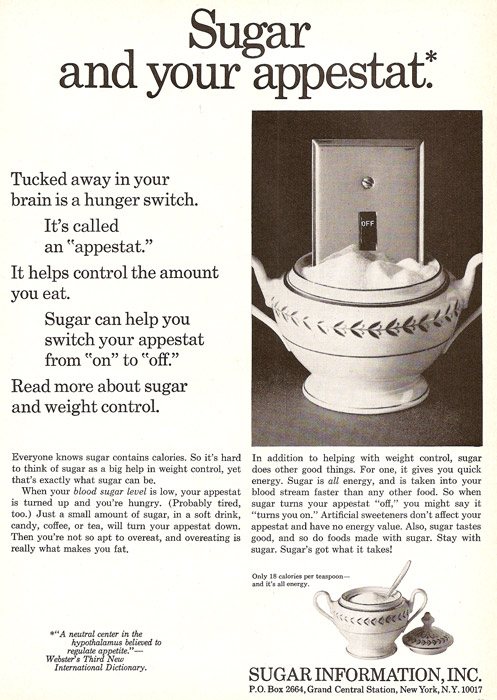
The fine print:
Everyone knows sugar contains calories. So it’s hard to think of sugar as a big help in weight control, yet that’s exactly what sugar can be.
When your blood sugar level is low, your appestat is turned up and you’re hungry. (Probably tired, too.) Just a small amount of sugar, in a soft drink, candy, coffee, or tea, will turn your appestat down. Then you’re not so apt to overeat, and overeating is really what makes you far.
In addition to helping with weight control, sugar does other good things. For one, it gives you quick energy. Sugar is all energy, and is taken into your blood stream faster than any other food. So when sugar turns your appestat ‘off,’ you might say it ‘turns you on.’ Artificial sweeteners don’t affect your appestat and have no energy value. Also, sugar tastes good, and so do foods made with sugar. Stay with sugar. Sugar’s got what it takes!
Only 18 calories per teaspoon…
and it’s all energy.
NEW (Dec. ’09)!
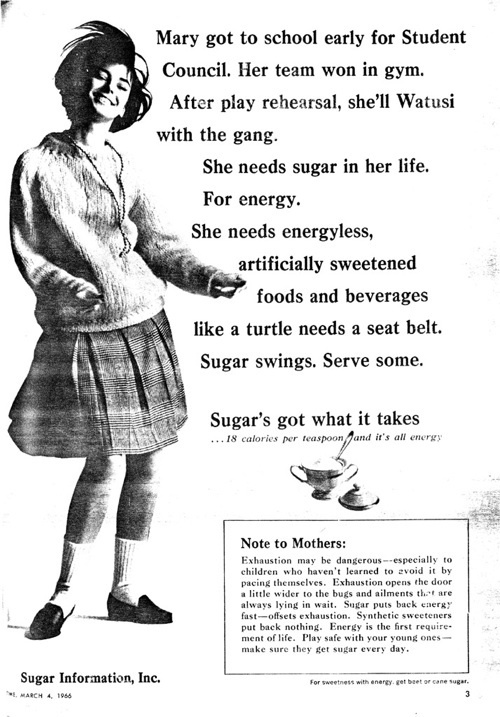
See also our recent post on marketing disguised as news.
—————————
Lisa Wade is a professor of sociology at Occidental College. You can follow her on Twitter and Facebook.
You might think that during an economic crisis that leads to job loss, workers might begin to think more positively about unions, seeing them as a possible buffer that would keep each individual worker from being completely on his or her own. But Nate Silver, over at FiveThirtyEight, posted a graph showing the relationship between the unemployment rate and public support for labor unions, based on historical data that goes back as far as 1948, and it’s distinctly negative:
Of course, support for unions has been decreasing in general since World War II, so some of the trend is likely due to that. But Silver says that even after controlling for the overall downward trend in support for organized labor, we see:
…a decrease in approval of 2.1 points for unions for every point increase in unemployment. Both relationships [this one, and the model without taking the overall downward trend into account] are highly statistically significant.
So what would explain this? The obvious answer would be that people must in some way blame unions for job loss–perhaps believing that they have negotiated pay and benefits that are too high and as a result have driven companies out of the U.S., causing people to lose jobs.
Or maybe some workers who were in unions blame them for not negotiating hard enough to keep their jobs–perhaps as people lose jobs, or see those around them losing theirs, they feel that their unions didn’t do everything possible to save their jobs, that union leaders got scared and gave in to corporate demands to allow layoffs. That might explain the decrease in support for some, though today unionization is low enough that it’s not enough to have a large impact on overall levels of support.
Another possible explanation is that during a time of rising unemployment, people simply feel they can’t afford to support unions–that they need a job now, and they’ll oppose unions and collective bargaining if they think that makes it less likely that employers will be hiring. In that case, they may not be blaming unions for unemployment directly, but may think that unions are a luxury that just have to be discarded when you’re desperate, individually or as a nation.
Thoughts?
My friend Larry, of The Daily Mirror, found some awesome old ads for Bull Durham tobacco. Here’s the original, with both a map of North America on his side and a scrotum that is partially obscured by still clearly present:
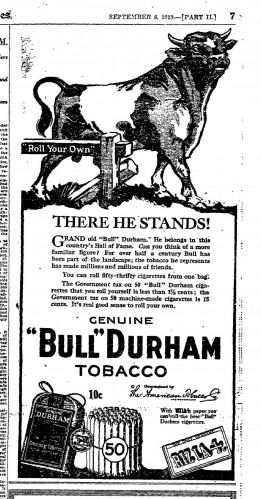
Here’s the version that ran from 1919-1924. Notice the difference?
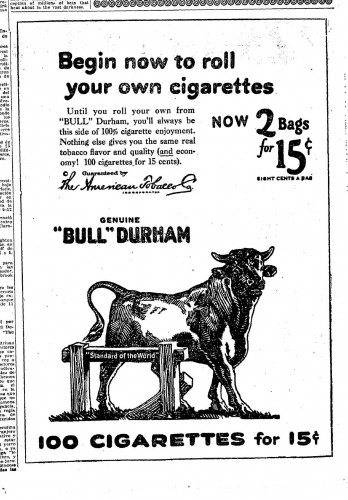
No more shocking reproductive organs! Also, he doesn’t have a map of North America on his side any more. As Larry says, clearly a subversive plot to try to symbolically emasculate the U.S., probably so the socialists could take over.
I do wonder what was going on during that particular time period that would make marketers at Bull Durham believe that a less anatomically correct version was necessary. Any thoughts (other than it being a subversive plot)?
More recently we saw men’s nipples airbrushed out of a Wrestle Mania billboard. On the other hand, testicles were added to a statue of Civil War General John H. Morgan sitting in his favorite horse, Bess…who, as you might have surmised, wasn’t a male horse and did not have testicles. But, you know, testicles made her look more appropriate for a military figure to ride.
Filibustering in the U.S. Senate (preventing a vote on a bill with continuous speech–or at least the threat of it, since often now a Senator just has to state that s/he intends to filibuster; if there aren’t 60 Senators to vote for cloture, they often just pretend the filibuster happened without making a person actually do it)–has been increasing over time:
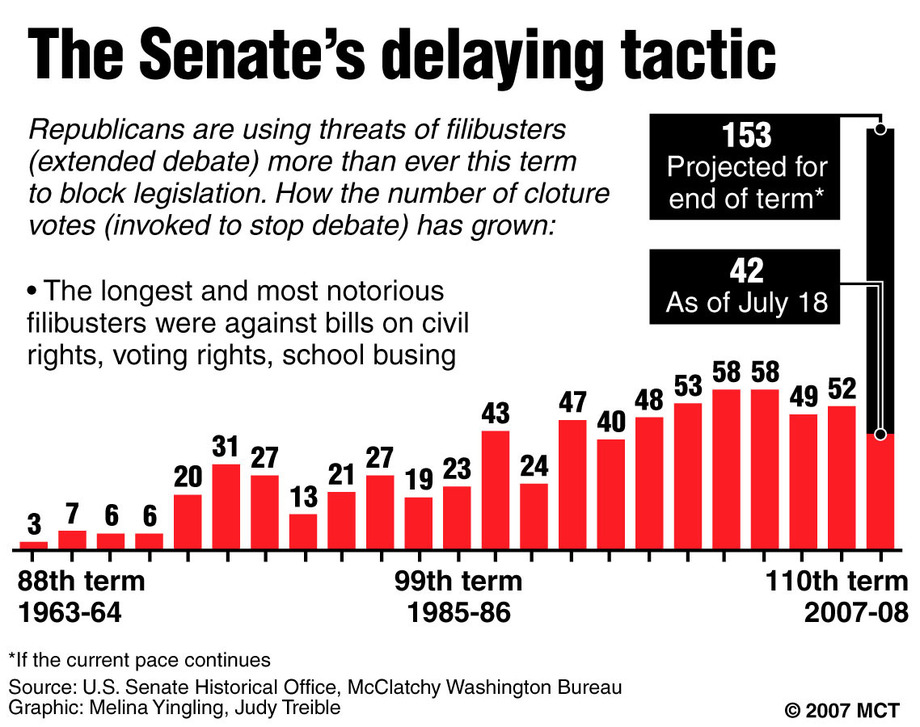
Why? Greg Koger at the Monkey Cage has a fascinating explanation (via Matthew Yglesias):
So why did the Senate change? The stock answer is that the chamber’s responsibilities grew with the size and scope of the federal government, so it became more costly to sit around watching obstructionists kill time. There is some truth in that explanation. Also, however, senators’ work habits changed. The introduction of railroads, cars, and (especially) air travel made sitting around in the Senate chamber so…boring. Tedious. Totally lame. During the mid-20th century, the Senate increasingly became a Tuesday-Thursday club, and individual senators began insisting that major legislation be kept from the floor to accomodate their travel schedules. A serious attrition effort would mean cancelled speeches in Manhattan and Chicago, no trips to the Delaware coast, and waiting longer to return to the ranch back in Texas.
—————————
Lisa Wade is a professor of sociology at Occidental College. You can follow her on Twitter and Facebook.
Depending on who you ask, the cash-for-clunkers program was a huge success or a huge failure, given that the demand was so enormous that it ran out of vouchers almost immediately. It’s almost as if fuel efficiency is finally starting to matter to the U.S. consumer after a decade or so of SUV-worship. However, this vintage ad for Volkswagen bus reveals that this is not the first time that U.S. car buyers have been concerned about efficiency:
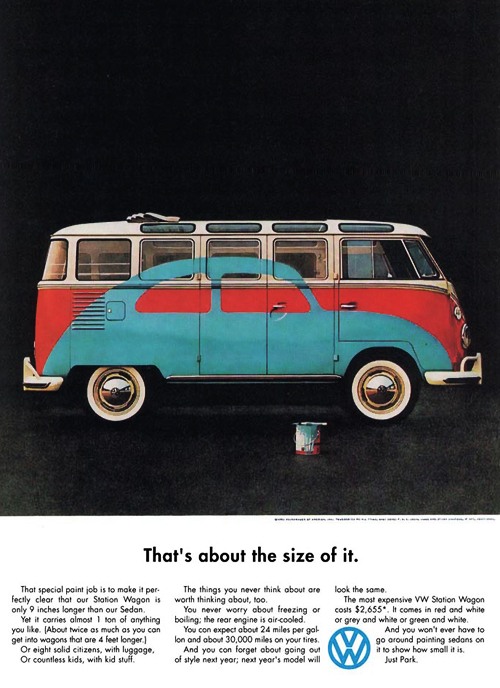
Text:
The special paint job is to make it perfectly clear that our Station Wagon is only 9 inches longer than our Sedan.
Yet it carries almost 1 ton of anything you like. (Almost twice as much as you can get into wagons that are 4 feet longer.)
Or eight solid citizens, with luggage.
Or countless kids, with kid stuff.
The things you never think about are worth thinking about, too.
You never worry about freezing or boiling, the rear engine is air-cooled.
You can expect about 24 miles per gallon and about 30,000 miles on your tires.
And you can forget about going out of style next year, next year’s model will look the same.
The most expensive VW Station Wagon costs $2,655. It comes in red and white or gray and white or green and white.
And you won’t ever have to go around painting sedans on it to show how small it is.
Just Park.
Via Copyranter.
See also this ad for Volvo from 1974.
—————————
Lisa Wade is a professor of sociology at Occidental College. You can follow her on Twitter and Facebook.
On the heels of our Frito Bandito post, comes this (I think) 1975 ad for Tequila Gavilan. Slogan: “One taste…and you’re not a Gringo anymore.”
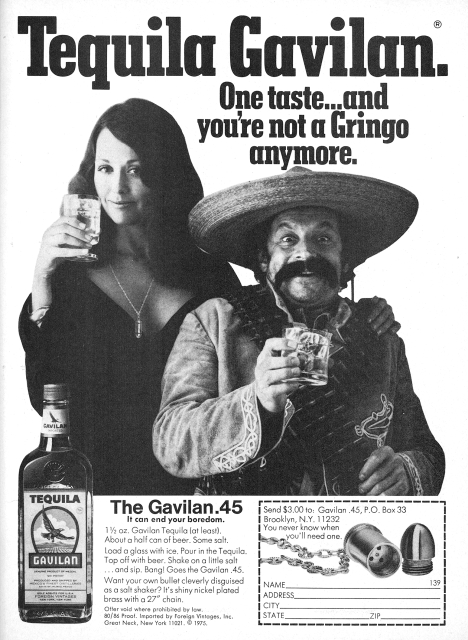
If I’m reading this ad correctly, both the woman and the man in this ad are supposed to be Mexican. What’s interesting, then, is the different social construction of Mexican men and women. While the male is the familiar “Frito Bandito,” sombrero-wearing fool, the female is a hot, spicy Latina. Today the Mexican fool is a risky stereotype to pull out, but the hot spicy Latina is still a very common trope.
From another angle, this reminds me a bit of the history of colonization and war. All too frequently, male ethnic others in war are considered enemies, while female ethnic others are considered the spoils of war. So the idea that the racially-othered men are disposable, while “their” women are desirable has a very long history in Western thought (see, for example, Joane Nagel’s great book, Race, Ethnicity, and Sexuality).
—————————
Lisa Wade is a professor of sociology at Occidental College. You can follow her on Twitter and Facebook.